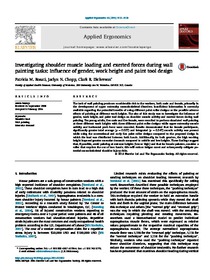Investigating shoulder muscle loading and exerted forces during wall painting tasks: influence of gender, work height and paint tool design

Rosati, Patricia M. ; Chopp, Jaclyn N. ; Dickerson, Clark R.
2014
45
4
1133-1139
body mechanics ; design of equipment ; gender ; muscle testing ; muscular work ; musculoskeletal diseases ; painting ; physical workload ; shoulder
Ergonomics and work environment
http://dx.doi.org/10.1016/j.apergo.2014.02.002
English
Bibliogr.
"The task of wall painting produces considerable risk to the workers, both male and female, primarily in the development of upper extremity musculoskeletal disorders. Insufficient information is currently available regarding the potential benefits of using different paint roller designs or the possible adverse effects of painting at different work heights. The aim of this study was to investigate the influence of gender, work height, and paint tool design on shoulder muscle activity and exerted forces during wall painting. Ten young adults, five male and five female, were recruited to perform simulated wall painting at three different work heights with three different paint roller designs while upper extremity muscle activity and horizontal push force were recorded. Results demonstrated that for female participants, significantly greater total average (p = 0.007) and integrated (p = 0.047) muscle activity was present while using the conventional and curly flex paint roller designs compared to the proposed design in which the load was distributed between both hands. Additionally, for both genders, the high working height imposed greater muscular demands compared to middle and low heights. These findings suggest that, if possible, avoid painting at extreme heights (low or high) and that for female painters, consider a roller that requires the use of two hands; this will reduce fatigue onset and subsequently mitigate potential musculoskeletal shoulder injury risks."
Digital
The ETUI is co-funded by the European Union. Views and opinions expressed are however those of the author(s) only and do not necessarily reflect those of the European Union or the ETUI.